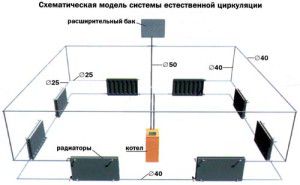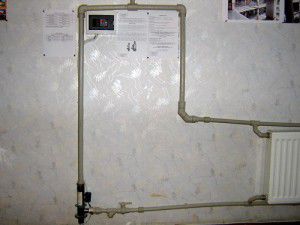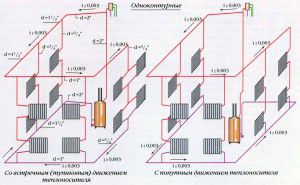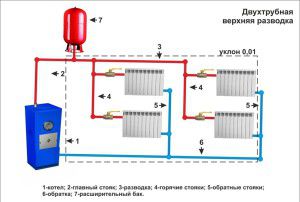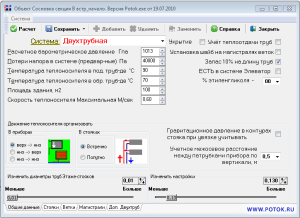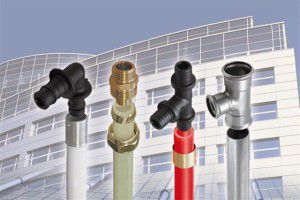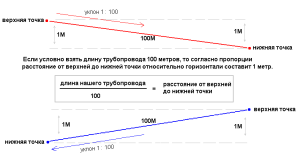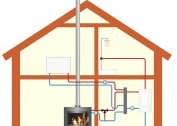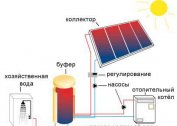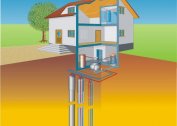Planning and installing heating with natural circulation is considered the most simple and inexpensive way to heat a house. However, for the practical implementation of such a project, one should know all the nuances and rules for choosing components. Therefore, the heating system of a private house with natural circulation should be correctly calculated and worked out the scheme of its installation.
The principle of operation of heating with natural circulation
For the operation of any water heating system, it is necessary to ensure the circulation of the coolant through the pipes. When heating in the boiler, hot water must flow into the batteries and radiators to transfer heat to the rooms of the house. Natural circulation water heating is no exception.
The movement of the coolant occurs due to the difference in density in the normal and in the heated state. When a working boiler enters the heat exchanger, an increase in water temperature occurs and, as a result, a decrease in density. Since the specific gravity of the cold coolant is higher, it begins to displace the heated one. As a result of this, a mass movement is formed.
Before you make water heating with natural circulation with your own hands, you should carefully familiarize yourself with the technical characteristics and specifics of operation:
- High degree of reliability. The absence of moving elements (impeller of the circulation pump) and atmospheric pressure ensure the long-term operation of the natural heating system of a private house;
- System inertia. Natural circulation in a closed heating system is ensured by a small pressure difference. Therefore, the rate of entry of hot water to the radiators will be minimal;
- Obligatory compliance with the slope of highways. For normal operation, the slope of the heating system with natural circulation must comply with the calculated data. Pipes are mounted with a slope from the boiler, and for the return pipe to the boiler. This ensures optimal system performance.
It should also be noted that the installation of a heating system with natural circulation is recommended for circuits with a pipeline length of not more than 30 m. Otherwise, a large volume of the cooled coolant will significantly reduce its speed.
The traditional heating scheme of a two-story house with natural circulation may include the installation of a gas, solid fuel or electric boiler. It is important that their design provides a system of protection against overheating in the event of reverse movement of the coolant or the occurrence of air jams.
Natural circulation heating circuits
First of all, you need to choose the correct layout of pipelines, radiators and a boiler. Since it is possible to make heating with natural circulation correctly only according to a previously drawn up plan - this stage of work needs to be given maximum attention.
At the first stage, an initial analysis of the room (house) is carried out, where it is planned to equip the heat supply system. It takes into account the living area, the degree of insulation of the external walls and the type of boiler for heating water. Currently, there are many schemes with which you can make heating with natural circulation with your own hands. The most popular are:
- Single tube. The best option for small houses and apartments;
- Double pipe. It is selected to provide air heating in houses with medium and large areas, two-story buildings.
However, taking into account the principle of operation of the heating system with natural circulation, one should keep in mind the main limitations - the total length of the highway, the minimum number of rotary nodes. Therefore, this scheme can not be used for collector or tee piping. Too large hydraulic losses will adversely affect the speed of the coolant.
When calculating a heating system with natural circulation, it should be borne in mind that only water can be used in this system. Antifreeze has too high a density that can not provide the proper pressure in the pipelines.
Single pipe system
For small country houses and country houses, when calculating the heating system with natural circulation, not only technical (operational) characteristics are taken into account, but also the total cost of the project. As a result, a reliable and low-cost heating system should be obtained. Therefore, most often in these houses a one-pipe heating system with natural circulation is made.
A feature of this system is the presence of one trunk. Radiators and batteries are connected to it in parallel, forming a single circuit. The main advantages of a single-tube heating system with natural circulation are the minimum number of components, low material consumption and ease of installation. However, it must be borne in mind that the cooling rate of the coolant in this system is quite high due to the sequential transfer of heat to each radiator in the circuit.
To optimize the thermal regime in the natural heating system of a private house, it is necessary to provide for the presence of such components:
- Bypass in the harness of each radiator. It will make it possible to limit the flow of coolant into the battery without changing the parameters of the entire system. With it, you can completely turn off the heater for replacement or repair without stopping the heat supply;
- Thermostats on batteries. They are mounted in a natural circulation heating system paired with a bypass. An automatic thermal element will change the cross-sectional area of the passage diameter of the radiator pipe, thereby regulating the degree of heating of the device;
- Mayevsky crane. Mandatory component in the radiator harness. Since it is not always accurate to calculate a heating system with natural circulation, you should consider a system for removing air. For this purpose the Maevsky crane is intended.
Another advantage of the natural circulation single pipe heat supply system is its small footprint. Installation of the trunk can be done both open and closed. It is only important to ensure that radiators are connected to it.
For a water heating system with natural circulation with one pipe, the boiler and radiators can be located on the same level, which is forbidden for other schemes.
Double pipe system
Stable operation of heating in medium and large houses can be ensured only with the separation of hot and cold water flows. In this case, the best option would be a two-pipe heating system with natural circulation.
For normal operation of the system, it is necessary to install the boiler below the level of radiators. This is necessary to create a pressure of cooled water, which creates natural circulation in a closed heating system. For a better head immediately after the boiler it is necessary to make an accelerating riser. An expansion tank is installed at its highest point. From it, a draft pipe is mounted at an angle to which radiators are connected.
A correctly calculated and installed two-pipe heating system with natural circulation will work even with a minimum temperature difference between the cooled and heated coolant. To implement such a project, the following nuances must be taken into account:
- Boiler location do-it-yourself water heating with natural circulation. Most often it is located in a basement or basement. It is necessary to ensure normal temperature conditions, ventilation and natural light;
- Inspection pipe on the expansion tank. Even if you correctly calculate the heating system with natural circulation, there will still be a chance of a critical decrease in the volume of water. Using the control pipe, you can track this indicator;
- Water recharge and drain units. They are located at the lowest point - on the return pipe. In order to properly make heating with natural circulation, it is necessary to foresee methods of automatic (semi-automatic) replenishment of the system, as well as rapid draining of water.
Thanks to the advent of new materials, it is possible to make a two-pipe heating system with natural circulation with your own hands from steel or polymer pipes. It all depends on the budget, the availability of appropriate tools and materials.
In a two-pipe heating system with natural circulation, bypass installation is optional. It is only important to provide for the installation of shut-off valves for the possible disconnection of the device from the common line.
Calculation of heating power with natural circulation
To calculate the main parameters of heat supply, it is recommended to use specialized programs. With their help, you can calculate the heating system with natural circulation as accurately as possible. But if this is not possible, other, simplified methods are used.
The easiest way is to calculate the required boiler power using the ratio of 1 kW of thermal energy per 10 m² of area. In this case, the result obtained must be multiplied by a coefficient that depends on the climatic conditions of the region.
Its values for the water heating system with natural circulation are given in the table. These ratios are recommended and can be replaced by others depending on the actual characteristics of the house. But in any case, this method will determine the approximate parameters of the heating system. Therefore, its use is a mandatory step in the design of heat supply.
|
Region |
Correction factor |
| South of Russia |
0.7 to 0.9 |
| Middle lane |
1 to 1.3 |
| Northern regions |
1.4 to 2 |
However, this does not take into account the degree of thermal insulation of the building, the number and characteristics of window and door structures. Therefore, it is best to use a different methodology for calculating a heat supply system with natural circulation. Stages of the calculations:
- For 1 m³ of residential building, 400 W of heat will be required. Multiplying power by the volume of the building, we get the initial value of thermal energy.
- To compensate for heat loss through the windows, the number of structures is multiplied by 100 watts. The same technique applies to exterior doors, but with a compensation of 200 watts each.
- If the room has an external wall, then for normal operation of the natural heating system of a private house, the result is multiplied by a correction factor of 1.2.
- For private homes, heat losses through the roof and floor are taken into account using a coefficient of 1.5.
It should be noted that even this calculation will be approximate. When planning the installation of heat supply with natural circulation do-it-yourself for a large house, it is recommended to contact specialists to accurately calculate the main characteristics of the system.
To minimize heat loss in the building, good thermal insulation of the external walls, ceiling, and roof is necessary.This will reduce the cost of doing the do-it-yourself, natural-circulation water heating costs.
Rules for drawing up a heating circuit with natural circulation
Knowing the basic principles of operation of the heat supply system with natural circulation and choosing the optimal scheme, you can proceed to complete the set. This stage is no less important than the previous ones, since the further work of heating will depend on the technical parameters of the components.
It is necessary to consider all the features of this system. In circuits with forced circulation, the compensation of hydraulic losses occurs due to the operation of the circulation pump. For systems with natural circulation in closed heating, such a mechanism does not exist. Therefore, to minimize losses, you should pay attention to the following points in the design and selection of components:
- Heating pipes. Their diameter should be from DN32 to DN40. This compensates for the friction of water on the inner surface. It is also recommended to choose polymer products with a smooth wall. Their actual outer diameter is from 40 to 50 mm;
- Line layout. It is necessary to avoid turning units that increase the hydraulic resistance in the system;
- Booster riser height. In the heating scheme of a two-story house with natural circulation, it should be higher than the ceiling of the second floor. The expansion tank is located in the attic;
- Characteristics of stop valves. Its presence should not affect the parameters of the system.
For a better understanding of the principles of operation of the heating circuit of a two-story house with natural circulation, an analogy can be drawn with the known communicating vessels. In this case, the boiler will be below the level of radiators, therefore, the fluid flow will circulate in its direction. That is why when developing a circuit and installing a heating system with natural circulation, it must be positioned as low as possible.
To prevent changes in the flow of water, a special valve is installed on the return pipe. This phenomenon can occur during the first start-up of the system, when the temperature difference between the coolant is small.
Natural draft heating slope
The installation of a heat supply system with natural circulation is practically no different from the standard technological scheme. To do this, use the same materials and tools. The difference lies in the mandatory bias of the heating system with natural circulation.
To ensure the operation of the system, the supply pipe from the riser must be inclined towards the radiators. The degree of change in the position of the upper and lower points of the supply line is determined by the ratio of 1:10. Those. for every meter of pipe a slope of 10 mm is required.
For the return line, the slope direction should be changed. In this section of the system, it should go from the radiators to the side of the boiler. Thus, an additional condition is created for the gravitational impact on the coolant.
One of the advantages of a natural circulation heating system is its maintainability. The owner of the house can independently eliminate the leak or replace the defective radiator. But for this it is necessary to purchase repair kits in advance.
The video shows a heating circuit with natural circulation with a detailed description of its operation and configuration:
